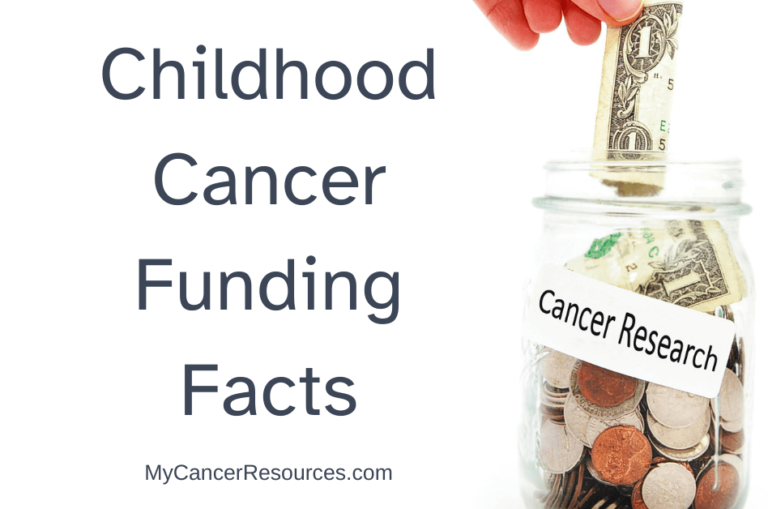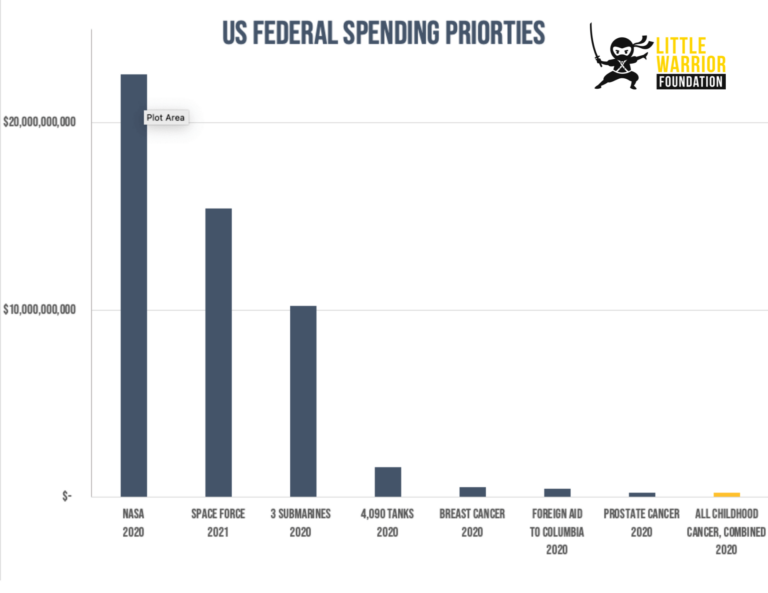
September is Childhood Cancer Awareness Month. I’ve already written a post on childhood cancer facts, but today I want to highlight the appalling lack of funding for childhood cancer research in the United States. Here are some childhood cancer funding facts and suggestions on what each of us can do to turn this around.
Funding is absolutely necessary when researching any type of disease.
Research funding helps to learn more about the disease, what causes it, and what the best treatment options are that have the fewest side effects.
Without funding, the research dries up, and so does the opportunity to find a cure for the disease that’s not only effective, but also less toxic.
There are 12 primary types of childhood cancer, and hundreds of subtypes. One would think that finding cures so that no child would have to suffer would be an important issue that the federal government wants to tackle, right?
Unfortunately, that’s not the case. Here are 2 statistics that blow my mind. I hope that you, too, are outraged and are moved to make a difference.
1. Out of the billions of federal funding dollars the U.S. Government spends on cancer research each fiscal year, ONLY 7% of these funds go toward finding a cure for childhood cancer.
2. Americans spend more on Starbucks in just 3 DAYS than the government spends on childhood cancer ALL YEAR LONG.
It used to be that a mere 4% of funding given to the National Cancer Institute (NCI) was for childhood cancer.
But with the passage of the Childhood Cancer Survivorship, Treatment, Access, and Research (STAR) Act and the Childhood Cancer Data Initiative, this amount has increased, which sounds great.
In reality, it’s still a small amount of funding to study cancer and try to not only reduce cancer incidence rates, but also develop less toxic drugs to cure more cancers and avoid the unwanted side effects of cancer treatments for children.
You may have seen the hashtag #MoreThan4 from many organizations trying to increase funding to study major types of pediatric cancers and adolescent cancers.
Due to their advocacy and President Biden’s Cancer Moonshot program, more money has been allocated to study solid tumors and blood cancers in children and adolescents.
But take a look at this graphic from Little Warrior. It shows a number of government programs and the amount of funding that each gets in a year.
The image is from 2020, so this is back when childhood cancer only received 4% of funding.
But even now, at just 7%, that line on the graph won’t move much.

Why is Funding So Low?
The reason for the low levels of funding is because childhood cancer is considered ‘rare’.
The definition of rare in the U.S. Rare Diseases Act of 2002 is when a disease affects less than 200,000 people. So technically, all childhood cancers are rare.
But since there could be hundreds of subtypes of just one type of cancer, this still means that far too many children are facing cancer and are all desperate for more effective treatments that don’t also cause dreadful side effects.
The National Institutes of Health will often put their research dollars into other areas – so something that affects more people, like breast cancer or other adult cancers, or where the research is already advanced enough that it’s easier to build upon it rather than starting almost from scratch.
Private Sector Involvement Makes a Huge Difference
Private and nonprofit organizations step in where others might step back. They’ve seen the gap and made a decision to try and fill it.
St. Jude Children’s Research Hospital is a shining example. This institution leads the fight against childhood cancer and best of all, never turns anyone away who may not be able to pay for their child’s treatment.
Thanks to their efforts, treatments and hope reach those children and families who might have otherwise been overlooked. Their involvement ensures research keeps moving forward.
This commitment transforms lives, turning despair into hope for many children.
There are other nonprofit organizations across the nation that work tirelessly to raise funds for cancer research and support promising researchers.
An example in my own community is The Fight Foundation. Started by a childhood cancer survivor who is now a doctor, this group raises money and supports innovative research grants to find a cure for pediatric cancer.
Today, about half of all childhood cancer research funding is raised by private organizations, individual donors, corporations and foundations.
Without the support of these types of organizations, many advancements in pediatric cancer research would stall, leaving new treatments and possibly the key to a cure out of reach.
The Impact of Funding on Advancing Research
Discovering the next successful cancer treatment takes a lot of money.
But the money that has already been invested into childhood cancer research has paid off.
New therapies, such as CAR-T treatment for acute lymphoblastic leukemia (ALL), which is the most common childhood cancer, has been a breakthrough that is continuing to save more and more precious lives. It’s important that research continues so that effective treatments are found for all types of pediatric cancers.
The NCI-supported Children’s Oncology Group (COG) conducts laboratory research and oversees clinical trials on children’s cancer.
Their studies look at not just cures, but also improving outcomes for survivors of childhood cancer. Quality of life is an important part of their research as well.
Since many survivors of pediatric cancer develop severe health problems or even a second cancer later in life as a result of their treatment, it’s critical that we don’t just save a life, but save it without burdening them in the future with additional health concerns.
COG consists of over 200 partnering children’s research hospitals, cancer centers and universities in North America, New Zealand and Australia. According to their website,
“The Children’s Oncology Group research has turned children’s cancer from a virtually incurable disease 50 years ago to one with a combined 5-year survival rate of 80% today.”
How incredible is that?!?!?!? Imagine what it could be if even more money was available for this literally life-saving research!
Empowering Change and Action
You might feel small, but your voice holds a lot of power. We need to rally together for more childhood cancer funding.
Every little bit of support pushes us forward. You can make donations to children’s cancer centers, or your local children’s hospital. You can spread the word and call on policymakers for change.
It’s not just about giving money. It’s about creating a wave of awareness.
Joining advocacy groups like the American Cancer Society puts you in a position to demand more. These organizations often know exactly where to direct effort for the maximum impact. They can guide you on how to speak to government officials or where your donation can do the most good.
Advocacy groups can also provide additional information on the specific types of childhood cancer like brain cancer, bone cancer, or leukemia.
They can provide the latest statistics and research developments so you can speak to those who have the power to directly benefit U.S. children by approving additional research funding.
Childhood cancer research has saved countless lives, but there’s still work to do. Together, we’re stronger.
Let’s not forget the power of sharing stories. By talking about personal experiences or sharing information on social media, you help light a fire under those who can make big decisions.
It’s about making sure no family feels alone in this fight and ensuring every child has a future to dream about.
Even the most simple action on your part could change lives.
Together, We Can Make a Difference
Childhood cancer touches many U.S. children and young adults. It is the leading non-accidental cause of death among this age group.
The numbers are even higher worldwide, and those in lower-income countries face even more struggles in accessing treatments.
Without research to find a cure, and then making those medicines accessible to children around the world, even more children will die.
Also important to study are:
* the causes of childhood cancer
* methods of improving the early detection of childhood cancer,
* psychosocial care and support for patients and their family members and
* caregiver support.
We can advocate for more public and private funds. If we don’t have money to give, there are lots of other ways we can support families facing a cancer diagnosis.
Imagine what could happen if researchers had enough funding. We could witness more success stories with children beating cancer and fewer families facing the agonizing wait for new treatments.
We must push for more funding for this critical work.
Every dollar invested brings us closer to a future where childhood cancer is no longer a leading cause of death among young ones.
What will you do today to be part of this change?



